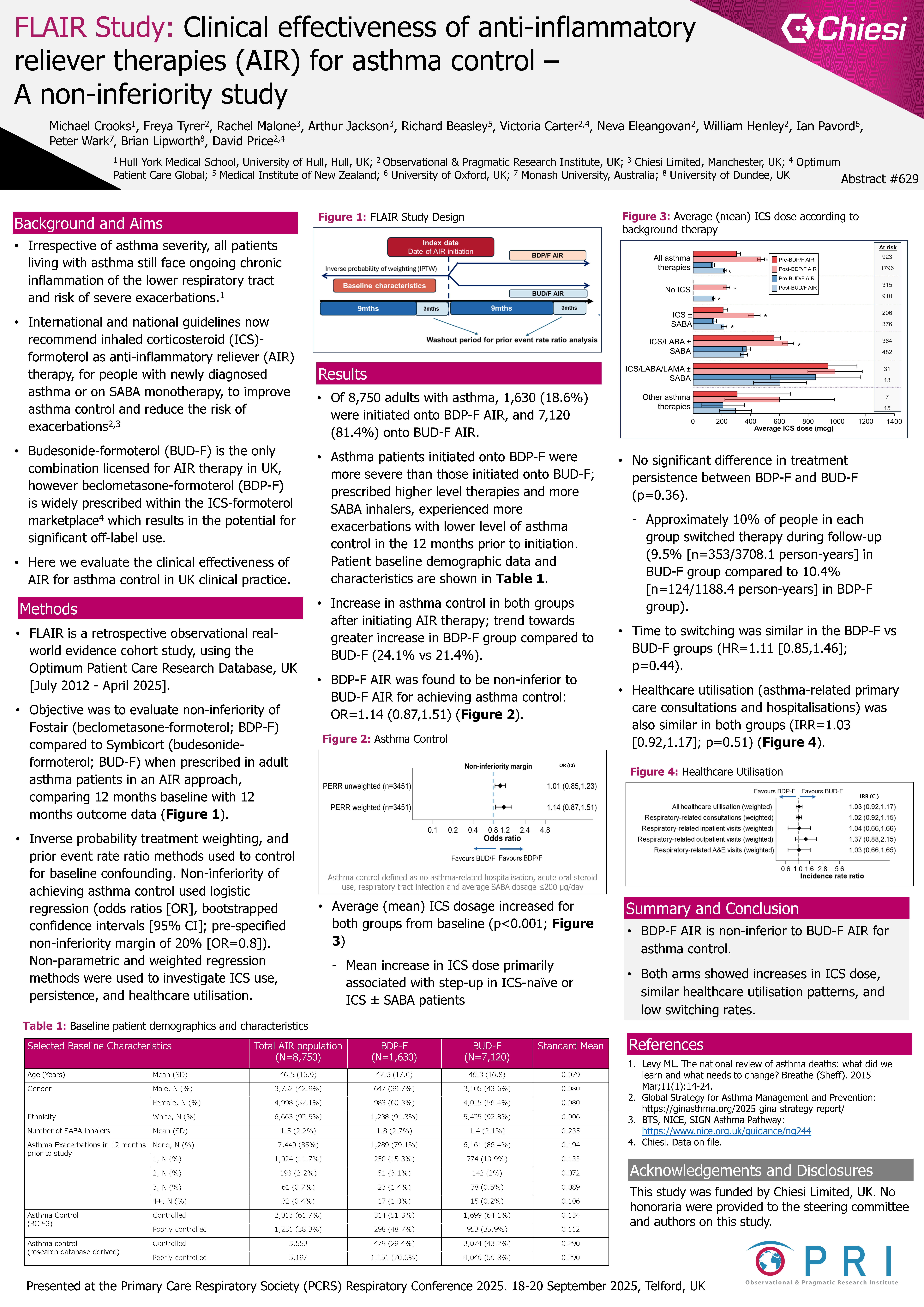Clinical effectiveness of anti-inflammatory reliever therapies (AIR) for asthma control: a non-inferiority study (ID 629)
Observational and Pragmatic Research Institute, United Kingdom
Abstract
Background & Aim
Anti-inflammatory reliever (AIR) regimens containing inhaled corticosteroids (ICS) and formoterol are recommended for people with newly diagnosed asthma or on short-acting beta2 agonist (SABA) monotherapy. Budesonide-formoterol (BUD-F) is the only combination licensed for as-needed AIR; however, beclometasone-formoterol (BDP-F) may also be used off-license. This non-inferiority study compared BDP-F (Fostair) with BUD-F (Symbicort) as AIR for asthma control. ICS use, persistence (switching) and healthcare utilisation were also compared.
Methods
A historical cohort study using the Optimum Patient Care Research Database, UK. Adults with asthma, no other chronic respiratory condition, and ≥1 year GP registration who initiated AIR (‘likely intent’ based on prescription instructions and ≤1 SABA inhaler during follow-up) for the first time since July 2012 were observed for a maximum of 1 year. Inverse probability treatment weighting (IPTW), adjustment and prior event rate ratio (PERR) methods were used to control for baseline confounding. Non-inferiority of achieving asthma control (absence of asthma-related hospitalisations, acute oral corticosteroids, lower respiratory tract infection, average SABA ≤200μg/day) used logistic regression (odds ratios [OR], bootstrapped confidence intervals [95% CI]; pre-specified non-inferiority margin of 20% [OR=0.8]). Non-parametric and weighted regression (Cox, Poisson) methods were used to investigate ICS use, persistence, and healthcare utilisation.
Results
Of 8,750 adults with asthma, 1,630 (18.6%) were initiated onto BDP-F AIR, and 7,120 (81.4%) onto BUD-F AIR between July 2012 and April 2025. BDP-F AIR was found to be non-inferior to BUD-F AIR for achieving asthma control: OR=1.14 (0.87,1.51). Average (mean) ICS dosage increased for both groups from baseline (p<0.001); baseline ICS use was higher in the BDP-F AIR group (62.5% vs 43.5%, p<0.001). Approximately 10% of people in each group switched therapy during follow-up; time to switching was similar in the BDP-F vs BUD-F groups (HR=1.11 [0.85,1.46]; p=0.44). Healthcare utilisation (asthma-related primary care consultations and hospitalisations) was also similar in both groups (IRR=1.03 [0.92,1.17]; p=0.51).
Conclusions
BDP-F AIR is non-inferior to BUD-F AIR for asthma control. Both arms showed increases in ICS dose, similar healthcare utilisation patterns, and low switching rates.
Funding: This is a collaborative study between Chiesi (UK) and Observational and Pragmatic Research Institute, United Kingdom.
Conflicts of interest: Richard Beasley has received institutional research funding from AstraZeneca and Teva, and personal fees from AstraZeneca and Teva.
Ian D Pavord has received personal fees from AstraZeneca, GSK, Sanofi-Regeneron, Amgen, Areteia , Circassia.
Michael Crooks has received grants from the National Institute for Health and Care Research, Asthma + Lung UK, AstraZeneca, Boehringer Ingelheim, Chiesi, Phillips, and Pfizer; honoraria, fees and/or non-financial support from AstraZeneca, Boehringer Ingelheim, Chiesi, GlaxoSmithKline, Orion, Novartis, Pfizer, Synairgen and Sanofi.
Brian Lipworth reports grants and personal fees from Chiesi, personal fees from Boerhingher Ingelheim, grants and personal fees from Meda, grants and personal fees from Teva, grants from Janssen, grants from AstraZeneca, grants from Roche, outside the submitted work.
Peter Wark report no conflicts of interests.
Rachel Malone and Arthur Jackson are employees of Chiesi Limited
Victoria Carter, Adam Marsh, Neva Eleangovan and Freya Tyrer are employees of Observational and Pragmatic Research Institute, United Kingdom.
David B. Price has advisory board membership with AstraZeneca, Boehringer Ingelheim, Chiesi, GlaxoSmithKline, Novartis, Viatris, Teva Pharmaceuticals; consultancy agreements with AstraZeneca, Boehringer Ingelheim, Chiesi, GlaxoSmithKline, Novartis, Viatris, Teva Pharmaceuticals; grants and unrestricted funding for investigator-initiated studies (conducted through Observational and Pragmatic Research Institute Pte Ltd) from AstraZeneca, Chiesi, Viatris, Novartis, Regeneron Pharmaceuticals, Sanofi Genzyme, and UK National Health Service; payment for lectures/speaking engagements from AstraZeneca, Boehringer Ingelheim, Chiesi, Cipla, Inside Practice, GlaxoSmithKline, Medscape, Viatris, Novartis, Regeneron Pharmaceuticals and Sanofi Genzyme, Teva Pharmaceuticals; payment for travel/accommodation/meeting expenses from AstraZeneca, Boehringer Ingelheim, Novartis, Medscape, Teva Pharmaceuticals.; owns 74% of the social enterprise Optimum Patient Care Ltd (Australia and UK) and 92.61% of Observational and Pragmatic Research Institute Pte Ltd (Singapore); is peer reviewer for grant committees of the UK Efficacy and Mechanism Evaluation Programme, and Health Technology Assessment; and he was an expert witness for GlaxoSmithKline.
